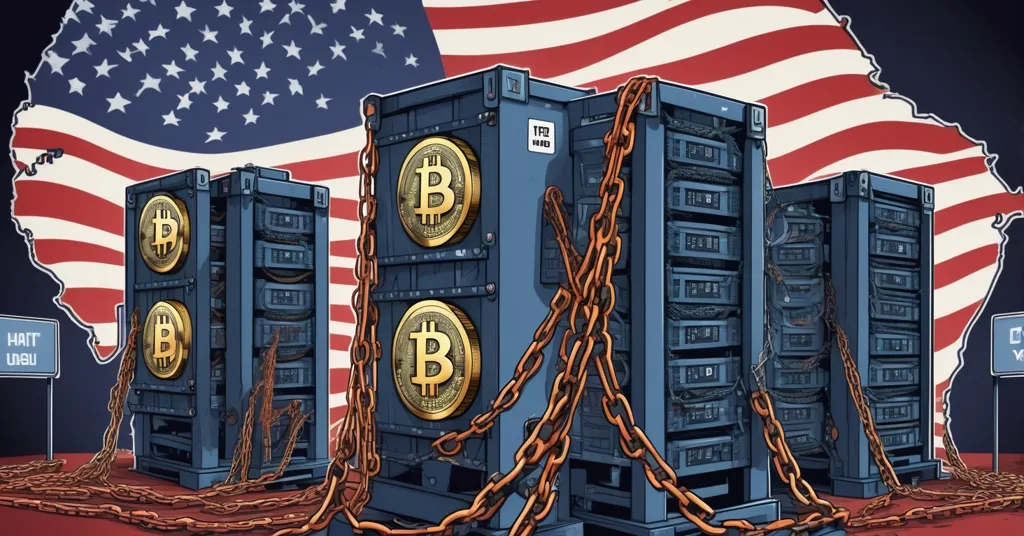Trump’s 2025 Tariffs Threaten U.S. Bitcoin Mining Leadership with Costly Hardware Duties

Trump’s 2025 Tariffs Jeopardize U.S. Bitcoin Mining Dominance
President Trump’s newly imposed import tariffs on Bitcoin mining hardware, finalized on July 31, 2025, and effective from August 7, are throwing a wrench into the U.S.’s drive to become a global leader in Bitcoin mining. With a 19% duty on gear from Southeast Asian powerhouses like Indonesia, Malaysia, and Thailand—bringing the total levy to 21.6% from a mere 2.6% pre-Trump—these policies are spiking costs and risking a hashpower exodus to more welcoming shores.
- Cost Surge: Tariffs jump to 21.6% on Southeast Asian mining hardware, up from 2.6%.
- Competitive Threat: U.S. miners face declining edge, eyeing Canada and Russia as alternatives.
- Domestic Hurdles: Local production efforts start, but full independence is years off.
Tariff Shock: Breaking Down the Numbers
For those new to the game, Bitcoin mining is the backbone of the network, powered by specialized machines called ASICs (Application-Specific Integrated Circuits). These rigs crunch complex math to validate transactions on the blockchain, earning miners fresh Bitcoin as a reward. But here’s the rub: most ASICs are built in Asia, with major production hubs in China and Southeast Asian nations like Indonesia, Malaysia, and Thailand. The U.S. has relied heavily on these imports to fuel its mining surge, especially after China’s 2021 ban on crypto mining sent a flood of hashpower—think of it as the computational muscle securing Bitcoin—straight to American soil. Now, Trump’s tariffs are slamming the brakes on that momentum, as detailed in this report on Trump’s tariffs threatening U.S. Bitcoin mining growth.
The numbers are a bitter pill. The 21.6% total duty on Southeast Asian imports, though dialed back from an initial proposal of 50%, hits hard. Imports from China face an even steeper 57.6%—a mix of a 10% reciprocal tariff and a 20% China-specific premium—down from a floated 145% but still punishing. Imagine shelling out for a $1,000 mining rig and getting slapped with an extra $216 just because of where it’s made. That’s the reality U.S. miners are grappling with under Trump’s “Liberation Day” trade reset, unveiled in April 2025, which aims to counter unfair trade practices but seems to be kneecapping a key crypto sector in the process, further explored in this analysis of the 21.6% tariff impact on mining hardware imports.
U.S. Competitiveness Takes a Hit
Ethan Vera, COO of Luxor Technology, a heavyweight in Bitcoin mining infrastructure, lays it out plain and simple.
“At 21.6% tariffs, the U.S. is now one of the least competitive jurisdictions to bring machines in,” Vera warns.
He’s not just whistling in the wind. Vera estimates a 20%+ spike in prices for locally sourced used ASICs as demand for tariff-free alternatives skyrockets. This isn’t just a small bump—it’s a barrier that could stall growth for U.S. mining operations, especially for smaller players or newcomers already squeezed by high energy costs in some regions. The risk? Capital flight to places where hardware doesn’t come with a government surcharge. Canada, with its cooler climate ideal for keeping rigs from frying, and more lenient import rules, is looking mighty attractive. Northern Europe, Brazil, and Paraguay tempt with cheap hydropower and regulatory clarity. Then there’s Russia, which Vera flags as a prime contender, a trend discussed in this piece on Russia and Canada emerging as alternative mining hubs.
“Russia is likely to be the main beneficiary,” Vera notes, pointing to cheaper hardware access and heavy Chinese investment.
Let’s chew on that for a second. Bitcoin’s strength is its decentralization—no single entity or region should dominate the network’s hashpower, as that opens the door to interference or attacks. If too much computational power clusters in a place like Russia, with its geopolitical baggage and spotty regulatory transparency, it’s a red flag for anyone who values Bitcoin’s censorship-resistant ethos. Are we solving one problem—protecting domestic industry—only to create a bigger one for the network’s integrity?
Policy Irony: Championing Crypto While Clipping Its Wings
Here’s where the plot thickens. Trump has been banging the drum on the campaign trail, promising to transform the U.S. into a “Bitcoin mining powerhouse,” positioning himself as a crypto ally. Yet, these tariffs, designed to shield American industries, are doing the opposite for mining. It’s a head-scratcher: how do you hype a borderless, decentralized technology while slapping punitive taxes on the very tools needed to sustain it? Mining isn’t about waving the stars and stripes; it’s about raw efficiency—cheap energy, affordable hardware, and a policy environment that doesn’t throw sand in the gears. A 21.6% hardware tax is more like a “Keep Out” sign scrawled in fine print than a welcome mat for innovation, a contradiction highlighted in this summary of 2025 tariff effects on mining hardware.
For Bitcoin maximalists—those who see BTC as the only true decentralized money—this isn’t just a business hiccup; it’s an existential gut punch. Bitcoin’s power lies in its resistance to control, rooted in a globally dispersed network of miners. If tariffs push hashpower into fewer, riskier hands, it chips away at Satoshi Nakamoto’s vision. Sure, protecting U.S. jobs sounds noble, but at what cost to the principles that make Bitcoin revolutionary?
Fighting Back: Domestic Production and Energy Hacks
But it’s not all doom and gloom—some U.S. miners are digging in their heels. Leo Lu, CEO of BitFuFu, a mining outfit expanding stateside, sees a path forward despite the tariff storm.
U.S.-based miners can maintain competitive margins with “low-cost, increasingly renewable energy in states like Oklahoma, Texas, and Colorado,” Lu asserts.
He’s onto something. Texas, for instance, has become a mining mecca thanks to rock-bottom electricity rates and a surge in renewable sources like wind and solar. These not only cut operational costs but also help counter Bitcoin’s bad rap as an energy guzzler—some estimates peg its annual consumption at over 100 terawatt-hours, rivaling entire small nations. If U.S. miners can power rigs with green grids, it’s a double win: lower bills and a chance to flip the script on environmental critics. BitFuFu is also forging local partnerships to soften the supply chain blow, betting on resilience over relocation.
Luxor Technology is playing a similar game, recently inking a deal with Chinese ASIC titan MicroBT to assemble hardware on U.S. soil. Sounds promising, right? Not so fast. Vera tosses a reality check into the mix, with more details available in this update on Luxor’s partnership with MicroBT for domestic production.
“Final assembly in the U.S. is possible today, but the raw materials and components largely come from Asia,” Vera admits.
In other words, even “Made in the USA” rigs are still chained to Asian semiconductors and parts—those tiny chips are the unsung heroes of every miner, and they’re not popping out of Silicon Valley yet. Building a fully domestic supply chain isn’t a flip-the-switch fix; it’s a grueling, years-long haul. Until then, tariffs keep inflating costs, and the market for used ASICs in the U.S. is turning into a gold rush—great if you’ve got hardware to sell, brutal if you’re trying to buy in.
Let’s not ignore the flip side of the renewable energy bet either. Wind and solar sound sexy, but they’re not always reliable—when the wind dies or clouds roll in, miners could be left scrambling for backup power at premium rates. And the upfront costs to set up green-powered farms? Eye-watering for smaller operations. It’s a long-term play, not a quick bandage for tariff wounds.
Global Hashpower Shuffle: History Repeating?
Zooming out, this tariff fiasco shines a spotlight on the nomadic nature of Bitcoin mining. Hashpower has always chased the path of least resistance—lowest costs, friendliest policies. When China cracked down in 2021, the U.S. snatched up nearly 40% of the global share, a golden era fueled by cheap imports and hungry energy grids. Now, with costs spiking, we might be watching that history rewind. Canada, Northern Europe, Brazil, and Paraguay are all on miners’ radar with their cost-effective setups. Russia, though, looms as the wildcard—cheap gear, yes, but also a potential centralization nightmare. If Bitcoin’s computational might starts pooling there, don’t be surprised if decentralization purists start losing sleep, as noted in discussions on U.S. competitiveness challenges under tariff policies.
Even altcoin miners—those using GPUs for coins like Ethereum Classic or Ravencoin—aren’t immune. While their hardware is more flexible than Bitcoin’s ASICs, often doubling as consumer-grade gear, they’re still feeling the sting of import cost hikes. The tariff ripple effect touches every corner of crypto mining, though Bitcoin’s specialized needs make it the hardest hit, a broader issue examined in this Q&A on how tariffs impact the mining industry.
Policy Wildcards and Devil’s Advocacy
A few glimmers of hope—or at least uncertainty—hover on the horizon. There’s talk of a 90-day extension on the tariff pause for Chinese imports, agreed in principle between the U.S. and China as of early August 2025, though it’s still awaiting a final stamp. If it clears, miners reliant on Chinese gear might catch a breather. But banking on policy flip-flops is like betting your mining farm on a dice roll—good luck with that. Luxor is also pushing hard for special tariff exemptions on ASICs, akin to those granted for laptops and servers under certain tech import codes. Will the administration budge? That’s the million-BTC question.
Playing devil’s advocate for a moment, tariffs aren’t pure villainy. In theory, they could spark a U.S. ASIC manufacturing boom—imagine a Silicon Valley for mining rigs, cutting reliance on foreign supply chains. But when “theory” collides with a years-long timeline, miners are stuck footing the bill in the meantime. And let’s not forget state-level dynamics: places like Texas, with their pro-crypto leanings, might push back against federal overreach, creating a patchwork of mining havens within the U.S. Could local defiance blunt the tariff edge? It’s a long shot, but worth watching, with additional context provided in this overview of tariff policies under Trump’s administration.
Key Takeaways and Critical Questions
- How are Trump’s 2025 tariffs affecting U.S. Bitcoin mining?
They’re jacking up costs with a 21.6% duty on Southeast Asian hardware and 57.6% on Chinese imports, eroding U.S. competitiveness and risking hashpower flight to other regions. - What are U.S. mining companies doing to adapt?
Firms like Luxor Technology and BitFuFu are pursuing domestic production deals with players like MicroBT and tapping low-cost renewable energy in states like Texas to offset expenses. - Can the U.S. still lead as a global Bitcoin mining hub?
It’s a steep climb—energy advantages and potential policy tweaks like ASIC exemptions offer hope, but current tariffs threaten to choke growth and cede ground internationally. - Which countries could capitalize on U.S. policy struggles?
Russia stands out with cheap hardware and Chinese backing, while Canada, Northern Europe, Brazil, and Paraguay lure miners with better import terms and energy costs. - How soon could a fully domestic U.S. ASIC supply chain emerge?
Experts like Ethan Vera suggest it’s years away, as even locally assembled rigs still depend on Asian components, keeping costs tied to global supply chains for now.
Bitcoin doesn’t play by borders, and hashpower follows the money. The U.S. has the tools to dominate—energy, ambition, and a vocal crypto cheerleader in Trump’s rhetoric. But these tariffs are a self-inflicted wound, and unless there’s a serious pivot or a domestic manufacturing miracle, we risk watching our mining dreams slip to hungrier players on the global stage. The clock’s ticking—will policy catch up to the promise, or are we handing Bitcoin’s future to someone else? For more on the broader implications, check this insight into U.S. mining dominance under tariff pressure.



